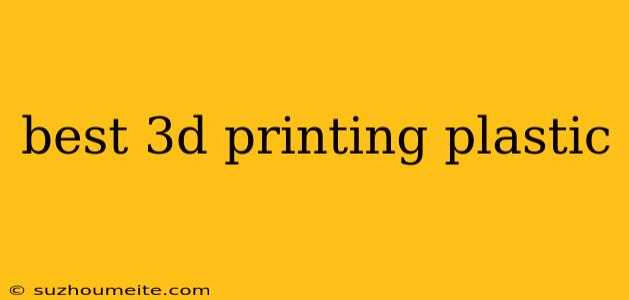Best 3D Printing Plastics: A Guide for Your Next Project
The world of 3D printing is rapidly expanding, offering a wide array of materials to choose from. Among them, plastics reign supreme, offering a balance of affordability, versatility, and ease of use. But with so many options available, how do you choose the best 3D printing plastic for your project?
This guide will delve into the top contenders, exploring their unique properties, benefits, and best applications.
PLA (Polylactic Acid)
PLA is a popular choice for beginners due to its ease of use, low printing temperature, and biodegradability. It is derived from renewable resources like corn starch, making it an environmentally friendly option.
Pros:
- Easy to print: PLA has a low melting point and is generally easy to print with.
- Strong and durable: It offers good tensile strength and impact resistance.
- Biodegradable: PLA is a biodegradable material, making it an eco-friendly choice.
- Versatile: It comes in a wide range of colors and finishes.
Cons:
- Not heat-resistant: PLA can soften and warp at high temperatures, limiting its applications.
- Brittle: It can be brittle and prone to breaking under stress.
Best applications:
- Prototyping
- Toys and models
- Decorative items
- Everyday objects
ABS (Acrylonitrile Butadiene Styrene)
ABS is a popular engineering-grade plastic known for its durability and impact resistance. It is often used for applications requiring high strength and rigidity.
Pros:
- Strong and durable: ABS is known for its high impact resistance and strength.
- Heat-resistant: It has a higher heat deflection temperature than PLA, making it suitable for applications requiring heat resistance.
- Easy to finish: ABS is easy to sand, paint, and glue.
Cons:
- Higher printing temperature: ABS requires a higher printing temperature than PLA.
- Warpage: ABS can warp during the printing process, requiring careful bed adhesion.
- Toxic fumes: ABS emits fumes during printing, requiring adequate ventilation.
Best applications:
- Durable tools and parts
- Automotive parts
- Industrial applications
- Prototyping
PETG (Polyethylene Terephthalate Glycol)
PETG is a strong and versatile plastic that offers a good balance of properties. It combines the durability of ABS with the ease of printing of PLA.
Pros:
- Strong and flexible: PETG is more flexible than ABS and offers good impact resistance.
- Good clarity: PETG offers good transparency, making it suitable for clear parts.
- Low warping: PETG is less prone to warping than ABS.
- Easy to print: PETG is generally easy to print with.
Cons:
- Higher printing temperature: PETG requires a higher printing temperature than PLA.
- Less heat-resistant: PETG is not as heat-resistant as ABS.
Best applications:
- Prototyping
- Packaging
- Containers
- Bottles and jars
Choosing the Right Plastic
Ultimately, the best 3D printing plastic for you depends on the specific needs of your project. Consider the following factors:
- Strength and durability: Do you need a strong, impact-resistant material?
- Heat resistance: Will your part be exposed to high temperatures?
- Flexibility: Do you need a flexible material?
- Clarity: Do you need a clear or translucent part?
- Ease of printing: How easy is the material to print with?
By considering these factors, you can make an informed decision about the best plastic for your next 3D printing project.
